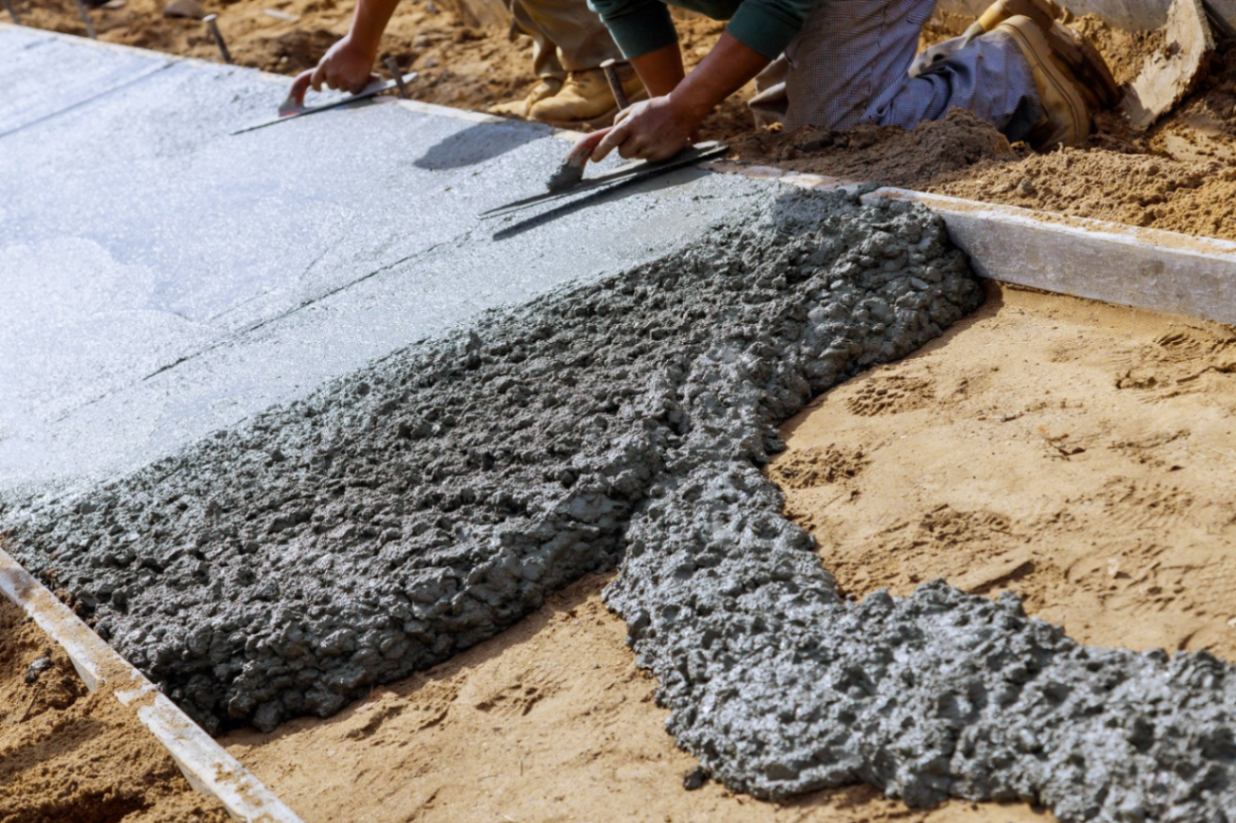In Marietta, GA, the seasonal weather conditions directly influence the success of your concrete projects. Hot summers can accelerate moisture loss, jeopardizing the curing process, while winter temperatures pose risks of frost damage. Additionally, unpredictable rainfall can compromise the integrity of your work. Understanding these factors is critical for achieving durability and strength in your concrete. What specific strategies can you implement to navigate these challenges effectively?

Key Takeaways
- High summer temperatures can cause rapid evaporation, disrupting concrete hydration and increasing the risk of incomplete curing.
- Winter temperatures below 32°F slow the curing process and increase the risk of frost damage, necessitating insulation and accelerators.
- Spring rainfall can lead to weak bonding and surface issues, making weather monitoring essential prior to pouring concrete.
- Fall conditions are optimal for curing; scheduling pours during midday helps ensure better results and reduces rain-related complications.
- Proper scheduling and adaptation to seasonal weather are crucial for achieving durable and long-lasting concrete structures in Marietta.
Understanding Marietta’s Climate and Its Implications for Concrete
Understanding Marietta’s climate is crucial when planning concrete projects, as the city’s seasonal variations can greatly impact material performance and installation techniques.
The region experiences humid subtropical climate conditions, characterized by hot summers and mild winters. These fluctuations affect concrete durability; high temperatures can accelerate curing, while colder temperatures may hinder it.
During winter, you must consider potential freeze-thaw cycles, which can compromise structural integrity if the concrete isn’t properly protected. Additionally, humidity levels influence moisture retention, potentially affecting the curing process.
The Effects of Summer Heat on Concrete Pouring
Marietta’s hot summer temperatures pose specific challenges for concrete pouring that you must address to guarantee successful installations.
The intense summer heat accelerates the evaporation of water, which can disrupt concrete hydration. When temperatures soar, you risk incomplete curing, leading to weakened structural integrity.
To mitigate these effects, consider adjusting your mix design by incorporating retarders, which slow hydration and extend workability. Additionally, pour during cooler parts of the day, such as early morning or late afternoon, to reduce temperature impacts.
Applying curing compounds and using wet burlap can also help retain moisture. By recognizing and adapting to the challenges posed by summer heat, you can assure a durable and high-quality concrete finish that withstands Marietta’s climate.
Managing Concrete Curing in Humid Conditions
While humidity can help maintain moisture in fresh concrete, it also presents unique challenges during the curing process. High humidity effects can lead to slower evaporation rates, which may seem beneficial, but can also hinder proper curing.
To manage this, you should employ effective curing techniques. Use curing compounds that form a moisture-retaining film on the surface, or consider wet curing methods, like covering the concrete with wet burlap or plastic sheeting.
Monitor the temperature closely, as high humidity can lead to increased heat, affecting hydration. Additionally, adjusting your mix design to include additives that improve workability and reduce water-cement ratio can boost performance under humid conditions.
Winter Weather Challenges: Freezing Temperatures and Concrete
As temperatures plunge during winter months, the risks associated with pouring and curing concrete increase considerably. You must be vigilant about frost damage, which can compromise the integrity of your projects.
When the temperature drops below 32°F, the curing process slows, making it vital to implement insulation methods to maintain proper heat. Using insulated blankets or heated enclosures can protect freshly poured concrete from freezing during the significant hydration phase.
Additionally, consider using accelerators to speed up curing times. Regularly monitoring the temperature of the concrete mix and the surrounding environment is essential.
The Role of Rainfall in Concrete Projects
Since rainfall can occur unexpectedly in Marietta, GA, it’s important to understand its impact on concrete projects.
Rainwater effects can greatly influence the curing process and overall integrity of concrete. Excess moisture can lead to issues like weak bonding, efflorescence, and surface scaling. Proper moisture management becomes vital to mitigate these risks.
Before pouring concrete, assess the forecast and prepare for potential rainfall. Utilize moisture-retaining measures, such as curing compounds, to shield your project from unexpected showers.
If rain does occur, monitor the surface closely for signs of damage and take swift action to address any issues.
Best Practices for Spring Concrete Work
When tackling concrete projects in spring, it’s crucial to take into account the fluctuating temperatures and moisture levels typical of Marietta, GA.
Effective spring preparation involves monitoring the weather closely, as sudden rain can impact curing times and strength. Utilize concrete techniques that adapt to these conditions, such as using additives for faster curing or employing curing blankets during cooler nights.
Confirm your surface is clean and free of debris before pouring, as this will improve adhesion and durability. Additionally, consider adjusting your mix design to include more water-resistant elements, guaranteeing better performance against spring’s unpredictable weather.
Fall Considerations for Concrete Installation
While you may enjoy the cooler temperatures of fall in Marietta, GA, it’s crucial to remain vigilant about how these changes affect concrete installation.
Begin by following key fall installation tips, such as scheduling pours during midday when temperatures are warmer. This helps guarantee ideal curing conditions. Additionally, protect freshly poured concrete from early frost, as it can compromise strength.
Implement autumn maintenance strategies by regularly checking the moisture levels in the concrete mix; cooler air can lead to increased humidity.
Keep the work area clear of debris, which can impact the surface finish. Finally, avoid installing concrete during periods of heavy rainfall, as this can weaken the integrity of your project.
Following these guidelines will improve the durability of your concrete installations this fall.
Temperature Fluctuations and Their Impact on Concrete Strength
Temperature fluctuations in Marietta, GA can greatly affect concrete strength during both cold and hot weather.
When temperatures drop, you face challenges like slower curing times and increased risk of freeze damage.
Conversely, high temperatures can lead to rapid evaporation and improper curing, compromising the structural integrity of your concrete projects.
Cold Weather Challenges
As cold weather sets in, the challenges posed by temperature fluctuations can considerably impact the strength and durability of concrete. When temperatures drop, the hydration process slows, leading to insufficient strength development.
You must implement frost protection measures to prevent freezing during curing, as frozen water within the concrete can cause expansion and cracking. Insulation methods, such as using thermal blankets or heated enclosures, can mitigate these risks by maintaining a stable temperature around the concrete.
Additionally, consider using winter-grade admixtures to improve performance in low temperatures. By addressing these cold weather challenges proactively, you can guarantee your concrete projects achieve the desired strength and longevity, despite the harsh conditions.
Hot Weather Risks
When the mercury rises, the risks associated with hot weather can substantially affect concrete’s strength and performance. High temperatures can lead to heat stress, which accelerates moisture evaporation, resulting in inadequate curing.
As a consequence, the concrete may not achieve its intended strength, making it prone to cracking and reduced durability. To mitigate these risks, you should employ effective insulation techniques, such as using wet burlap or curing compounds to retain moisture.
Additionally, scheduling concrete placement during cooler parts of the day can minimize exposure to excessive heat. By understanding these factors and implementing appropriate strategies, you can improve the performance and longevity of your concrete projects in Marietta, GA, even during the hottest months.
Seasonal Timing: When to Schedule Your Concrete Projects
Choosing the right time to schedule your concrete projects is essential for guaranteeing ideal results.
In Marietta, GA, timing considerations greatly impact the curing process and overall durability of your concrete. Spring and fall are typically the best seasons due to moderate temperatures and lower humidity, promoting best hydration and strength development.
Avoid scheduling conflicts during peak rainy months, as excess moisture can weaken the mix and lead to complications. Additionally, be mindful of local events or holidays that may affect project timelines.
Adapting Techniques and Materials for Marietta’s Climate
To achieve ideal results in your concrete projects, it’s crucial to adapt techniques and materials to Marietta’s unique climate. The hot, humid summers and mild winters demand careful consideration.
When adapting materials, choose concrete mixes designed for warmer temperatures, incorporating additives that improve workability and reduce setting times.
Utilize seasonal techniques like shading freshly poured concrete to prevent rapid moisture loss during intense heat. In cooler months, consider using insulated blankets to maintain ideal curing conditions.
Additionally, adjusting your pouring schedule to early mornings or late evenings can mitigate temperature extremes. By employing these strategies, you’ll guarantee your concrete projects withstand Marietta’s climate, delivering durability and longevity.
Frequently Asked Questions
How Does Humidity Affect Concrete Drying Times in Marietta?
Humidity affects concrete drying times greatly. High humidity levels slow evaporation, leading to drying challenges. You’ll need to adjust your approach, possibly extending curing times to guarantee the concrete sets properly without compromising strength.
What Types of Concrete Are Best for Marietta’s Weather Conditions?
For Marietta’s climate, you should use weather resistant mixtures with temperature sensitive additives. These materials improve durability and performance, ensuring your concrete withstands fluctuations in temperature and humidity effectively, leading to longer-lasting results.
Can Seasonal Allergies Impact Concrete Work Schedules?
Yes, seasonal allergies can impact your concrete work schedules. Allergy considerations, like worker health and productivity, often lead to project delays. Ensuring ideal conditions for your team is essential for maintaining timeline efficiency and overall project success.
How Should I Prepare My Site for Seasonal Rains?
To prepare your site for seasonal rains, implement effective drainage solutions and guarantee proper site elevation. This minimizes water accumulation, protects your work area, and improves the durability of your concrete projects.
What Are Signs of Concrete Damage From Seasonal Weather Changes?
You’ll notice signs of concrete damage through crack patterns like diagonal and horizontal fractures. Additionally, freeze-thaw cycles can exacerbate these issues, causing spalling and scaling, which indicate your concrete’s integrity is compromised under seasonal weather changes.
Conclusion
In Marietta, GA, understanding seasonal weather is vital for successful concrete projects. Hot summers demand careful management of curing to prevent evaporation, while winter’s freezing temperatures pose risks for strength and integrity. Rainfall can compromise your efforts, making timing critical. By adapting your techniques and materials according to the seasons, you can improve durability and guarantee your concrete installations stand the test of time. Stay informed and proactive to achieve ideal results for your projects.
